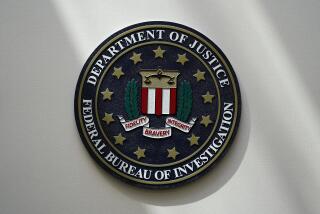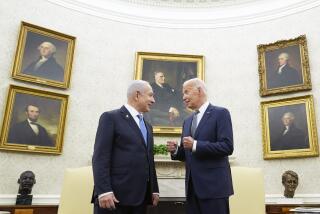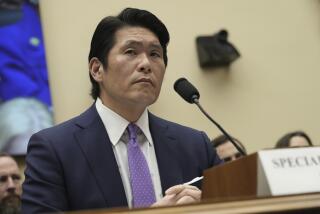A public look at Al Qaeda leader’s private library
- Share via
Reporting from Washington — Suffice it to say Osama bin Laden’s bedside table held no beach reads or steamy novels.
But the Obama administration’s release Wednesday of more than 400 documents, reports, books and other materials that were seized by U.S. Navy SEALs during the 2011 raid that killed the Al Qaeda chief in Pakistan provides new insight to the mind-set of the man who sponsored the Sept. 11 terrorist attacks.
The trove, the largest of its kind, suggests Bin Laden closely followed U.S. counter-terrorism policy and debates, regularly downloading congressional hearing transcripts and reports, unclassified military papers from West Point and Justice Department indictments of some of his adherents.
He also downloaded applications for U.S. passports, visas and other immigration documents, presumably with an eye toward sending more skyjackers or other terrorists to America.
Correspondence shows that he had hoped to launch another mass-casualty assault on the 10th anniversary of the 2001 attacks.
Curiously, the haul also included a video game guide for “Delta Force: Xtreme 2,” manuals for Dreamweaver and Tinderbox software, silk-screening instructions and a sports nutrition pamphlet. U.S. officials speculate that they were for his children or wives, several of whom lived with him.
He bookmarked stories from Time, Newsweek and a film review from January 2005 in the Los Angeles Times titled “Is Al Qaeda Just Bush’s Boogeyman?” He followed think tanks in Washington, London, Ottawa and elsewhere, and assembled 19 reports on France’s economy and military capabilities.
Bin Laden’s private library held 39 English-language books, all nonfiction, by writers as diverse as journalist Bob Woodward to linguist Noam Chomsky. How they came to be in his high-walled hide-out in Abbottabad, Pakistan, remains unclear, but the list proved awkward for at least some of the authors.
“He was probably disappointed — like most of my readers — in what he got out of it,” said Michael O’Hanlon, whose 2008 book “Unfinished Business: U.S. Overseas Military Presence in the 21st Century,” was among the works found.
Paul Pillar, a former senior CIA official, seemed impressed to learn that Bin Laden had downloaded his 2004 article “Counterterrorism after Al Qaeda.”
“It wasn’t as if I was offering him advice,” he quickly said.
The article, which now appears prescient, encouraged counter-terrorism officials to prepare for the growth of terrorist groups in North Africa and the Arabian Peninsula, as well as so-called lone-wolf attacks in Western countries. It correctly anticipated that Al Qaeda’s central command structure would soon give way to more independent regional franchises.
Bin Laden “was a bit of an international relations policy wonk,” said Daniel Benjamin, a former State Department counter-terrorism coordinator who now teaches at Dartmouth College. The Al Qaeda leader’s papers “suggest he was smart enough to be interested in how his enemy thought and functioned,” Benjamin said.
Christine Fair, an expert on South Asian military affairs at Georgetown University, and the only female author on the list, called it “weird” to see her 2006 book, “Fortifying Pakistan,” on Bin Laden’s reading list. It outlines the failure of U.S. attempts to prevent Pakistan from becoming a haven for terrorist groups.
“I just imagine him reading that book and thinking, ‘Yeah, this is … a permanent terrorist sanctuary,’“ she said.
Bin Laden’s collection also includes several notorious conspiracy theories, including a 1928 tome called “The Secret Teachings of All Ages” by the late Los Angeles-based mystic Manly P. Hall, “Secrets of the Federal Reserve” by Holocaust denier Eustace Mullins, and “Bloodlines of the Illuminati” by Fritz Springmeier.
“He certainly understood how to wrap insanity around kernels of truth,” Fair said. “That is the core of a conspiracy.”
Bin Laden invariably spoke in Arabic in interviews and in videos. But he came from a wealthy Saudi family and was highly educated, so apparently he was sufficiently fluent in English to read the material he collected.
The trove also includes dozens of newly declassified letters, written in Arabic but summarized or translated into English, to and from Al Qaeda lieutenants around the globe.
Bin Laden wrote about fundraising and recruiting young leaders as well as how to exploit the political unrest roiling the Middle East and North Africa in the so-called Arab Spring protests shortly before he was killed in May 2011.
One document appears to be an Al Qaeda job application form. It asks about hobbies and criminal convictions, and for a contact number to call if the applicant dies and becomes a “martyr.”
“What objectives would you like to accomplish on your jihad path?” the form asks. “Do you wish to execute a suicide operation?”
The Office of the Director of National Intelligence published the material on its website under the label “Bin Laden’s Bookshelf,” with a scowling black-and-white portrait of the bearded terrorist leader.
Hundreds more documents are under review and may be released “in the near future,” said Jeffrey Anchukaitis, a directorate spokesman. “All documents whose publication will not hurt ongoing operations against Al Qaeda or their affiliates will be released.”
The material comes as the administration struggles to gain ground in Iraq and Syria against Islamic State, the Al Qaeda breakaway faction that has overshadowed Bin Laden’s network as a terrorist threat around the world.
The release also serves to rebut claims by reporter Seymour Hersh that the SEAL commandos took nothing from the compound, and that the White House account of the raid was an elaborate hoax. U.S. officials said the release was not related to Hersh’s story and is part of the administration’s compliance with a congressional requirement, passed last year, to release as many of the Bin Laden documents as possible.
Overall, the material reveals more about Bin Laden’s years in forced solitude than it does about the terrorist network that killed nearly 3,000 Americans, as well as thousands of other innocents in attacks from Bali, Indonesia, to Madrid.
During his five or so years in Abbottabad, Bin Laden was cut off from the Internet. But he watched hours of television streamed in by satellite, a U.S. counter-terrorism official said, and may have requested books and articles by American experts who appeared on news or talk shows.
Relatives and underlings wrote messages to him in digital files that were delivered on thumb drives by courier, according to U.S. officials. He kept up a surprisingly tender correspondence with a wife and several sons who hadn’t seen him for nearly a decade.
They include a handwritten letter, dated Aug. 15, 2008, in which Bin Laden gives one of his wives instructions should he be killed. He told her that he wouldn’t object if she were to remarry, but added, “I really want for you to be my wife in paradise.”
Bin Laden’s correspondence shows him struggling to direct a terrorist network that was increasingly embroiled in regional conflicts, rather than focused on attacking the West as he wished.
“He was intent on attacking the far enemy and not the local Arab despots,” Benjamin said. “He wanted a catastrophic attack against the United States that would get America to pull out of the Middle East.”
For more reporting on national security, follow @ByBrianBennett.
More to Read
Sign up for Essential California
The most important California stories and recommendations in your inbox every morning.
You may occasionally receive promotional content from the Los Angeles Times.











